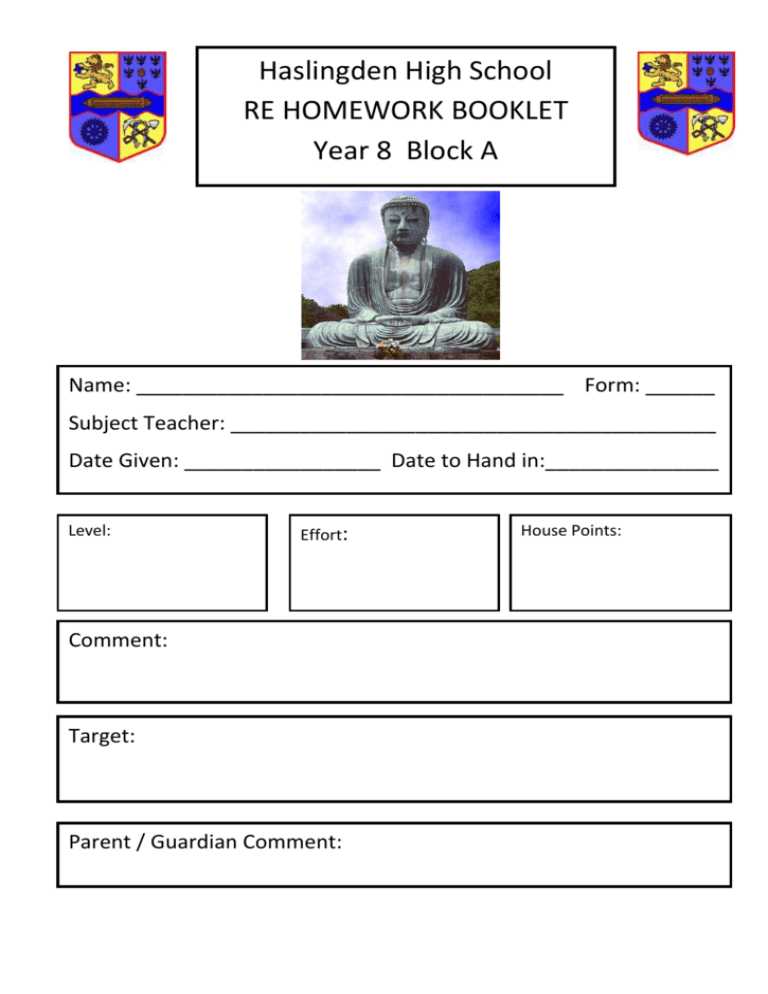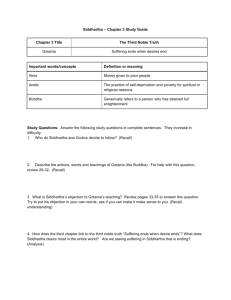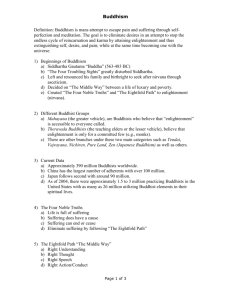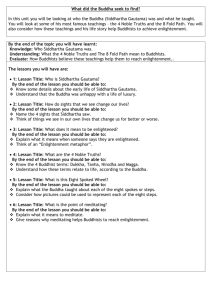Haslingden High School RE HOMEWORK BOOKLET Year 8 Block A
advertisement

Haslingden High School RE HOMEWORK BOOKLET Year 8 Block A Name: _____________________________________ Form: ______ Subject Teacher: __________________________________________ Date Given: _________________ Date to Hand in:_______________ Level: Effort: Comment: Target: Parent / Guardian Comment: House Points: Year 8 Block A Homework Religious Education – Buddhism Buddhism is one of the most fascinating religions in the world. In this booklet you will be studying the key teachings of Buddhism as taught by the Buddha, the founder of Buddhism. The booklet begins by looking at the life of the Buddha before concentrating on the Four Noble Truths and the Eightfold Path, some of the most important aspects of Buddhist teaching. You will be asked to think carefully about these teachings and consider what difference they might make to people’s lives. The final task is an essay that asks you to think about different points of view. This is the most important part of your homework and your level for this booklet will be awarded for this essay. Each task has a suggested time with it – this is the time your teacher suggests you spend on each task. The Life of the Buddha Read the following story and answer the questions at the end. Buddha was born in India about the 2600 years ago. He was a Hindu and the son of a King. His name then was Siddhartha Gautama. When he was born, a holy man said to the King that the child would be either a great ruler or a great spiritual leader. Siddhartha’s father, wanted his son to be king one day. He kept his child in the palace and would not let him see the real world outside. Siddhartha was very clever and enjoyed the best that life could offer. He was well known for his kindness to others. When Siddhartha became a man, he married a beautiful princess, and they had a beautiful son. In spite of having everything that he could wish for – a loving wife and a wonderful son – Siddhartha was not totally happy. He felt that there was something missing. Against his father’s wishes, he left the palace one day to see what was outside the walls. 1. Why was Siddhartha not totally happy? _________________________________________________ _________________________________________________ _________________________________________________ Even though the King had given strict orders that the Prince should never see anyone poor, sick or unhappy, Siddhartha came across four things he had never seen before. He came across a man who was very old. His servant explained that the man was suffering from old age. Siddhartha was horrified to discover that old age could affect anyone. Then they came across a lady who was very ill. Siddhartha was told that she was suffering from a disease. Later, they saw a funeral and Siddhartha learned that everyone dies one day. 2. What were the three things that upset Siddhartha? i) ii) iii) Finally, Siddhartha and his servant came upon a man by the roadside. He was sitting upright, eyes closed. The servant explained that this was a holy man who had given up all his possessions and his place in the community to try and discover the meaning of life. 3. The holy man made a big impression on Siddhartha. Why do you think this was the case? _________________________________________________ _________________________________________________ _________________________________________________ _________________________________________________ Siddhartha could not rest. He spent some time trying to make sense of the suffering he had seen and decided to leave the palace and his family. He promised that he would not return until he had found a way to deal with the problem of suffering. 4. Why did Siddhartha give up everything he had? _________________________________________________ _________________________________________________ _________________________________________________ _________________________________________________ When Siddhartha left home, he went deep into the forest. He took off his rich clothes and put on a simple yellow robe and cut his hair. He stayed with holy men and learned a great deal from them about meditation. He learned to go deep inside himself to find peace, calm and wisdom. Even after six years of this, he did not feel as though he had found a way to deal with suffering. He set out alone and decided to fast. Eating only one grain of rice each day, he starved himself. He thought that this would sharpen the power of his mind and that he would be able to meditate more deeply. It did not help. In the end, Siddhartha decided that the only way to find an answer was to follow a Middle Way. He found a quiet, beautiful place, sat down and said that he would not get up again until he had found a way to go beyond the power of death and suffering. Siddhartha was tempted to give up many times. The demon Mara sent pretty girls to tempt him to give up. He was tempted by fame and wealth. He began to think he was too weak, but he didn’t give in. At last, he discovered the deepest sense of calm, peace and happiness. He began to think that he was deep within himself. At that moment, Siddhartha became Buddha – the one who is awake. Buddha was a changed man and everyone he met was astonished because it seemed he glowed with love, happiness and peace. He realised at last that the answer to suffering lay within him. 5. What does it mean to say Siddhartha was “awake”? _________________________________________________ _________________________________________________ _________________________________________________ _________________________________________________ This next section concentrates on the Four Noble Truths, the Buddha’s teachings about suffering. Buddha taught about the causes of suffering. Most Buddhists would agree that the Four Noble Truths are the most important part of the Buddha’s teaching. First Noble Truth Buddha taught that all life is suffering. 6. What does the word ‘suffering’ mean? ___________________________________________________ 7. Give three examples of ways people might suffer? 8. Collect images that show a range of suffering. Look at magazines, newspapers and the internet. Using the space on the next page stick your images creating a collage. As illustrated by your collage, all humans suffer. Buddha then moved onto the Second Noble Truth. Second Noble Truth Suffering is caused by greed and selfishness 9. Stick a picture here of a mobile phone that you would really like to have. Buddha taught that wanting things makes us unhappy. If we don’t get what we want, we are unhappy. If we get what we want, then we will soon want the next thing 10. Why did the Buddha say that wanting things makes us unhappy? ___________________________________________ ___________________________________________________ ___________________________________________________ Buddha taught that all humans have selfish desires. Humans are greedy and will always want. We are all concerned with what we want rather than the needs of other people. This selfishness is a cause of suffering in the world. Third Noble Truth Greed and selfishness can be stopped. Buddha taught a third Noble Truth, that that suffering will stop if we crush our desires. When you no longer want things, when what we want is no longer important Buddha taught that this is when suffering will stop.. 11. Do you agree that desire (wanting things) causes suffering? ______________________________ 12. Can you give a reason for your answer? _________________________________________________ ___________________________________________________ ___________________________________________________ ___________________________________________________ ___________________________________________________ Fourth Noble Truth Selfishness and greed can be stopped by following the Eightfold Path. Buddha taught that there is a path to stop selfishness and greed. This path is called The Eightfold Path. This shows Buddhists the way to live - eight “right” ways humans should live their life. Right Understanding Right Concentration Right Thoughts Right Speech Right Mindfulness Right Effort Right Actions Right Living Read the meaning of some parts of the Eightfold Path. Spoke of the wheel Meaning Right Thoughts Make your thoughts as unselfish as possible. Do not think as if you were the most important person in the world. Think about other people too. Right Speech Do not tell lies or spread gossip. Don’t be rude or harsh when you speak. Right Actions Behave in a way that will not bring suffering to others. Right Living Have a lifestyle that avoids harming anything as much as possible. Right Effort Put all your effort into living the right way. 13. Choose two parts of the Eightfold Path you have just read about. Then complete the table below. One row has been done to help you see what to do. Spoke of the Wheel. Right Effort Meaning How could I do this?. Put all your If I put all my effort into my school work, then I know that I have done my effort into living best. I can be happy if I have done my best. the right way. I know that my teachers and those that care for me will be proud of me if I try my best. Buddhist Stories To complete this next task you will need to use the internet and go to www.youtube.com On YouTube, search for way of Buddha animation Now you need to click on this link You can watch the whole programme, but the most important section is from starts at 5:00 minutes and ends at 7:16 minutes. This is a story about a woman called Kisa Gotami. Watch this section very carefully and the complete the work on the next page. 14. Now fill in the gaps on Kisa Gotami’s story. There are some words at the bottom of the next page to help you. A woman called _________ came to the Buddha in tears, holding the body of her dead baby ______. She was so upset that she had been everywhere to try to bring him back to _____. Her friends felt sorry for her and told her to go and see the Buddha. When Gotami found the Buddha, she said to him, “Please bring back my son to life.” Very gently, the Buddha answered, “I can help you Gotami, but first you must bring me something. I need one small ____________ seed. However, this seed must come from a _______ where no-one has ever died.” Gotami quickly went in search of a mustard seed. She went to the first house. A woman answered the ________ and Gotami asked her “I need a mustard seed, but it must come from a house where no-one has ever died. Do you have a mustard seed?” The woman at the door replied, “I would be happy to give you a mustard seed, but my ___________ died last year.” Gotami thanked the woman and said, “I must continue my search somewhere else.” Gotami went to another house. But the same thing happened again. This time a young girl answered the door and Gotami asked her for a mustard seed. The girl said she was sorry, but her mother had ________ a few weeks ago, so she could not help Gotami in her search. Gotami kept searching all day for a house where no-one had ever died, but she could not find one. Everyone wanted to help her, but at every house someone had died before. At the end of the day, Gotami returned to see the___________. The Buddha asked her, “Where is your mustard seed? Where is your son? You are not carrying him anymore.” Gotami replied, “Oh sir, today I have found that I am not the only one who has lost a ______ one. Everywhere I have been people have died. Now I see how foolish I was to think I could have my son back. I have accepted that he is dead and this afternoon I ______________ my son. Now I have come back to listen to you teach me. I am ready to listen.” The Buddha then said, “Gotami, you have learned a great deal today. ____________ and death must come to everyone sooner or later. If you learn the truth, you can live and die in ____________. Come and sit here and I will ____________ you.” So the Buddha taught Kisa Gotami and she was very happy. Word bank husband teach Buddha happiness died Gotami loved cremated son mustard door life house suffering This is the final task. Your answer to this question will be the one used to give your work a level. Level You can describe what the Buddha was trying to teach 3 Kisa Gotami. Level You can explain what the Buddha was trying to teach Kisa 4 Gotami, showing how she reacted to what she learned. 15. Which of the Four Noble Truths does this story tell us about? Explain your answer. _________________________________________________ _________________________________________________ _________________________________________________ _________________________________________________ _________________________________________________ _________________________________________________ _________________________________________________ _________________________________________________ _________________________________________________ _________________________________________________ _________________________________________________








